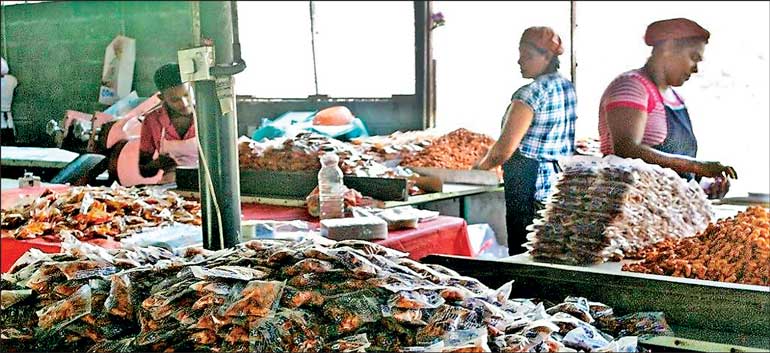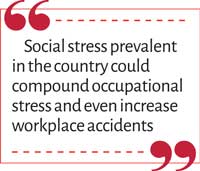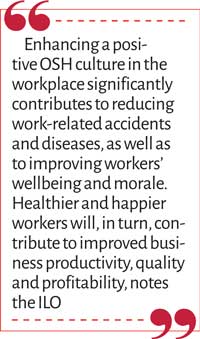Sunday Apr 20, 2025
Sunday Apr 20, 2025
Thursday, 28 April 2022 00:00 - - {{hitsCtrl.values.hits}}

Safety in the informal sector cannot be undermined
By Randima Attygalle
Occupational safety and health (OSH) should cut across all industries and all workplaces and not just
 |
| Dr. Champika Amarasinghe |
confine to high-risk work environments, says National Institute of Occupational Safety and Health (NIOSH) Director Dr. Champika Amarasinghe. “It is not only about physical injuries but a lot more involving occupational stress, poor ergonomics and more,” observes the NIOSH Director who goes on to say that social stress prevalent in the country could compound occupational stress and even increase workplace accidents.
“People are easily provoked and this could even lead to violence at the workplace,” points out the NIOSH Director who also alludes to potential occupational hazards that the present energy crisis could trigger. “Many factories and offices are compelled to store fuel for generators which need to be properly stored, especially in highly inflammable environments such as printing presses, chemical factories, etc.”
Promoting OSH literacy
OSH literacy still remains distant to many Sri Lankans, says Dr. Amarasinghe who points out that ideally disseminating OSH literacy should begin at school level. She also calls for a more proactive approach to OSH at organisational level.
to OSH at organisational level.
The commitment towards OSH should also go beyond legal provisions, Dr. Amarasinghe says. “The arrest of a factory owner or compensation for a lost limb is not the end of the story. What is at stake is human life which cannot be quantified. The commitment towards OSH should go beyond legal provisions by creating enhanced OSH literacy among the people.”
Commenting on this year’s theme for World Day for Safety and Health at Work which is ‘Promotion of a preventative culture on OSH based on participation and social dialogue’, she says that the OSH calls for a tri-pronged approach of employer-employee and government involvement coupled with behavioural change. The responsibility cast on the employers to empower their workforce on OHS although significant, the reality is otherwise, maintains the community physician. “A very few employees/workers would know how to operate a fire extinguisher and where fire exits are placedinside their office. OSH should ideally be an ingrained feature of a workplace culture.”
Occupational accidents and diseases
Around 2.9 million workers die every year due to occupational accidents and diseases and at least 402 million people suffer from non-fatal occupational injuries according to the ILO Report on World Day for Safety and Health at Work 2022. Examining 41 pairs of specific risk factors and health outcomes, the WHO/ILO Joint Estimates of the work-related burden of disease and injury, 2006 to 2016 global monitoring report indicates that work-related diseases were responsible for 81% of all work-related deaths, with deaths due to occupational injuries accounting for the remaining 19% of work-related deaths.
The occupational risk factor with the largest number of attributable deaths was exposure to long working hours (resulting in 745,000 related deaths), followed by exposure to particulate matter, gases and fumes – resulting in 450,000 deaths. Not only do occupational injuries and illness cause immeasurable human suffering to victims and their families, they also entail major economic losses for enterprises and economies as a whole – which may be measured in terms of health care costs, compensation costs, production losses, reduced work capacity and lower workforce participation, the ILO report notes.
Findings of the NIOSH reveal that there is only a slight difference between work-related accidents and road accidents in Sri Lanka. “Other than the National Hospital of Sri Lanka, work-related accidents and deaths are not reported under that label, but as mere accidents. Therefore a significant number of work-related deaths go unreported. Even the available statistics do not reflect the actual picture which often dilutes the gravity of the situation,” says the NIOSH Director.
Occupational accidents and diseases are estimated to contribute to 5.4% of annual global gross domestic product (GDP) lost according to the International Commission on Occupational Health (ICOH). Less tangible costs contribute towards broadening the economic impact; these include presenteeism (working with less effectiveness), productivity losses associated with permanent impairment, and staff-turnover costs (i.e., loss of skilled staff) the report says. Giving appropriate priority to the prevention of occupational accidents and diseases and providing adequate investments in occupational safety and health (OSH) will contribute to sustainable economies, thereby ensuring a healthy workforce and supporting productive enterprises, notes the ILO.
(working with less effectiveness), productivity losses associated with permanent impairment, and staff-turnover costs (i.e., loss of skilled staff) the report says. Giving appropriate priority to the prevention of occupational accidents and diseases and providing adequate investments in occupational safety and health (OSH) will contribute to sustainable economies, thereby ensuring a healthy workforce and supporting productive enterprises, notes the ILO.
Social dialogue on safety
This ILO report calls for the promotion of a preventative culture on OSH based on participation and social dialogue – the theme of this year’s World Day for Safety and Health at Work. Social dialogue is defined by the ILO as ‘all types of negotiation and consultation, or simply the exchange of information between, or among, representatives of governments, employers and workers on issues of common interest relating to economic and social policy’. Social dialogue may be informal or institutionalised, and often includes both. It can take place at different levels (international, national, regional, local or workplace). It may involve the social partners in different economic sectors, within a single sector or in a single company or group of companies.
Enhancing a positive OSH culture in the workplace significantly contributes to reducing work-related accidents and diseases, as well as to improving workers’ well-being and morale. Healthier and happier workers will, in turn, contribute to improved business productivity, quality and profitability, notes the ILO.
Safety and informal sector
Although OSH is part of the DNA of many large companies and factories here at home, it is often undermined in the informal sector including the SMEs. The National Policy Framework for SME Development introduced by the Ministry of Industry and Commerce recognises SMEs as the ‘backbone of the economy’ accounting for more than 75% of the total number of enterprises, providing 45% of the employment and contributing 52% towards GDP. “The contribution of the informal sector including SMEs to GDP is as important as the contribution made by sectors such as garments, tea and foreign employment. Yet, the informal sector which includes SMEs doesn’t come within the health and safety legislature of the country. This is a serious concern as occupational hazards, disability levels and other accidents in this sector do not get reported.” To address this concern, NIOSH collaborated with a few more government agencies to launch an OSH awareness project last year which was funded by the ILO.
The National Safety and Health Management System developed by NIOSH now extends to SMEs as well. This enables SMEs to introduce cost effective OSH interventions including certification systems at an affordable price. Getting international certifications is a costly process which most of the SMEs cannot afford and NIOSH aspires to fill the gap with home-grown standards. In a bid to empower stakeholders in the plantation sector, NIOSH has launched several initiatives including exposing plantation managers to best practices at leading multinational factories based here, training of the employees on behavioural changes related to OSH, development of an employer guide and a manual for the plantation sector and carrying out OSH audits which identified specific hazards within the industry for which recommendations for improvements were provided. The exercise, which covered several districts, has been hampered due to the unsettling condition prevalent in the country including the fuel crisis, Dr. Amarasinghe says.
New career paths
The Higher National Diploma in OSH which was launched by the NIOSH especially for those who require special training in OSH, is now an NVQ Level 6 certified qualification. This qualification also enables an ‘unconventional career path’ for young job seekers, points out Dr. Amarasinghe.
The OSH Excellence Awards now into its third year recognises best OSH practices in industries. The awards scheme also promotes self-compliance towards safety and health among the industries, benchmark the best safety practices among different industries, uplift the local industrial safety standards to international OSH practices, share the best OSH knowledge among the practitioners, promote the legal compliance towards Factories Ordinance, ensure a safe workplace to minimise occupational diseases and accidents in industries, change and enhance behaviour based safety in the country, strengthen the industrial peace and harmony and promote international concepts such as ‘decent work’.
In a landscape of evolving industries and work arrangements, the need for new legal provisions related to OSH is urgent, notes Dr. Amarasinghe. Despite this urgency, the proposed Occupational Safety, Health and Welfare Act still remains unrealised. “Beyond the legal framework, a collective behavioural change is vital in order to champion a positive safety and health culture.” Moreover, in a backdrop of a rising ageing population and non-communicable diseases (NCDs) Sri Lanka cannot afford to carry the extra burden of work-related accidents, she says.
Discover Kapruka, the leading online shopping platform in Sri Lanka, where you can conveniently send Gifts and Flowers to your loved ones for any event including Valentine ’s Day. Explore a wide range of popular Shopping Categories on Kapruka, including Toys, Groceries, Electronics, Birthday Cakes, Fruits, Chocolates, Flower Bouquets, Clothing, Watches, Lingerie, Gift Sets and Jewellery. Also if you’re interested in selling with Kapruka, Partner Central by Kapruka is the best solution to start with. Moreover, through Kapruka Global Shop, you can also enjoy the convenience of purchasing products from renowned platforms like Amazon and eBay and have them delivered to Sri Lanka.
Discover Kapruka, the leading online shopping platform in Sri Lanka, where you can conveniently send Gifts and Flowers to your loved ones for any event including Valentine ’s Day. Explore a wide range of popular Shopping Categories on Kapruka, including Toys, Groceries, Electronics, Birthday Cakes, Fruits, Chocolates, Flower Bouquets, Clothing, Watches, Lingerie, Gift Sets and Jewellery. Also if you’re interested in selling with Kapruka, Partner Central by Kapruka is the best solution to start with. Moreover, through Kapruka Global Shop, you can also enjoy the convenience of purchasing products from renowned platforms like Amazon and eBay and have them delivered to Sri Lanka.